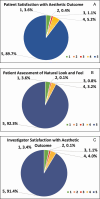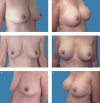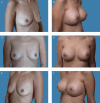Five-Year Safety and Satisfaction With the Lightweight Breast Implant
- PMID: 33564821
- PMCID: PMC8844999
- DOI: 10.1093/asj/sjab054
Five-Year Safety and Satisfaction With the Lightweight Breast Implant
Abstract
Background: The B-Lite lightweight breast implant (LWBI) weighs approximately 30% less than traditional silicone implants while maintaining an equivalent size, form, and function. The LWBI thus places less stress on breast tissues and preserves tissue stability and integrity over time, reducing weight-related complications and reoperation rates.
Objectives: The authors sought to assess the long-term (>5 years) safety and performance of the LWBI in primary and revision augmentation procedures.
Methods: A retrospective, single-center, single surgeon analysis of prospectively collected data was performed on 827 consecutive primary and revision augmentation patients operated between December 2013 and January 2019. A total 1653 implants (250-835 cc, mostly round, textured, extra high-profile) were implanted employing standard surgical techniques. Direct physician-to-patient follow-up ranged from 6 to 67 months. Chart data on reoperations and overall complications as well as patient and surgeon satisfaction were analyzed.
Results: The 5-year per patient Kaplan-Meier reoperation free rate was very high (97.1%). Only 2 of 5 total cases of capsular contracture (CC) grade III required reoperation (Kaplan-Meier rate = 0.2%, CI = 0.1-1.0). No cases of rupture or breast implant-associated anaplastic large cell lymphoma were recorded. A total 94.9% of patients rated the aesthetic outcome, and 95.5% of patients rated the natural look and feel of their breasts at 4 to 5 (satisfied-very satisfied). Similarly, the surgeon rated 4 to 5 on 95.4% of the patients' aesthetic outcomes.
Conclusions: The favorable safety profile, high patient and surgeon satisfaction, and inherent benefits of reduced weight should make the LWBI a strongly considered strategic alternative to traditional implants.
© 2021 The Aesthetic Society.
Figures







Comment in
-
Commentary on: Five-Year Safety and Satisfaction With the Lightweight Breast Implant.Aesthet Surg J. 2022 Feb 15;42(3):273-274. doi: 10.1093/asj/sjab154. Aesthet Surg J. 2022. PMID: 33780528 No abstract available.
References
-
- American Society of Plastic Surgeons. 2018 Plastic Surgery Statistics. Accessed April 27, 2020. https://www.plasticsurgery.org/news/plastic-surgery-statistics.
-
- The Aesthetic Society’s Cosmetic Surgery National Data Bank: Statistics 2019. Aesthet Surg J. 2020;40(Suppl 1):1–26. - PubMed
-
- U.S. Food and Drug Administration. Update on the Safety of Silicone Gel-Filled Breast Implants (2011) – Executive Summary. Accessed April 27, 2020. https://www.fda.gov/media/80685/download.
MeSH terms
Substances
LinkOut - more resources
Full Text Sources
Other Literature Sources
Medical

